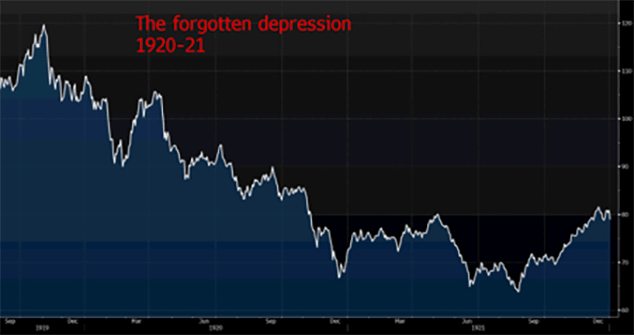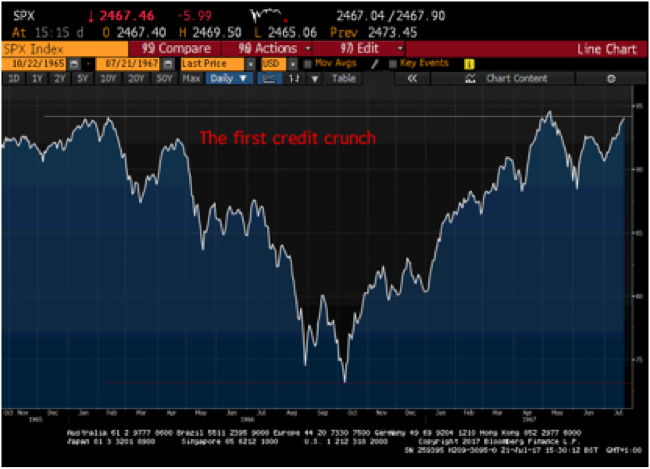What we can learn from the bond market crash of the late 1960s
John Stepek casts an eye back to the slow, painful bond market crash of 1967-71 to see what investors can learn about the current bond bubble.

Good morning, and welcome to the latest in our series on market crashes of the past.
This week, we'll be looking at the slow but painful bond market crash of 1967 to 1971.
If you fancy catching up on others in the series before you read that, of particular relevance might be last week's, in which we looked at what happened when the bond market crashed in 1994.
MoneyWeek
Subscribe to MoneyWeek today and get your first six magazine issues absolutely FREE

Sign up to Money Morning
Don't miss the latest investment and personal finances news, market analysis, plus money-saving tips with our free twice-daily newsletter
Don't miss the latest investment and personal finances news, market analysis, plus money-saving tips with our free twice-daily newsletter
You might also want to look at the credit crunch of 1966, which I looked at from the perspective of the equity market.
And if you just like reading about crashes (I know I do) then do check out the strange tale of the depression that no one knows about.
And now onto the crash that might just serve as a useful blueprint for today's bond market...
The bond market crash of the late 1960s
So what happened to bonds in the late 1960s and early 1970s?
Paul Schmelzing of Harvard University wrote about the era in a brief study of bond market crashes for the Bank of England earlier this year. The decline in bond prices between 1967 and 1971 fits into a pattern that he describes as an "inflation reversal", which is a grim state of affairs for bondholders.
It's what you get when inflation makes a sudden comeback or rather, when the bond market re-evaluates its overly-low inflation expectations. Between 1965 and 1970, US bonds fell by 36% in real terms (ie, after inflation). During the same period, annual consumer price inflation rose from 1.6% to 5.9%.
Do bear in mind that this wasn't the end of the crash by any means it was practically a warm-up for the mid-1970s, which is when inflation really took off.
The reason I wanted to look at the 1967 to 1971 phase in more detail today is because this is also the type of crash that Schmelzing sees as being the biggest risk to bondholders now.
As mentioned above, I've already written about the credit crunch of 1966, so you might want to have a glance at that piece for some background. But I'll fill in the necessary details here.
In the early 1960s, as Sidney Homer and Richard Sylla put it in their A History of Interest Rates, the US economy saw "the most unusual period of stability in the postwar period". Interest rates (as measured by investment grade bond yields) remained broadly stable around the 4.5% mark. Inflation was low, and investors remained tentative.
However, "an entirely new and revolutionary phase of bond market history began in 1965". President Lyndon B Johnson had launched the Great Society reforms in 1964. In effect, this was an attempt at a "New Deal" for the 1960s, trying to eradicate poverty and address racial injustice.
What it meant in economic terms was more government spending, which all else being equal tends to be inflationary. Meanwhile, spending on the Vietnam War was ramping up too. Taxes were cut significantly too, a policy that had originally been laid out by John F Kennedy prior to his assassination in 1963.
But probably more importantly, the economy was doing well, and after a period of caution, businesses were becoming more optimistic. Unemployment fell from 5.2% in 1964 to 4.5% in 1965, and 3.8% in 1966.
How inflation caught bond investors unawares
In short, what happened is that government spending (and tax cutting) was ramping up at a time when the economy was already picking up pace. That's a recipe for inflation.
But bond investors had grown used to a pretty benign environment and they'd grown complacent (I'll throw in the Hyman Minsky quote again: "Stability breeds instability").
So they weren't ready for inflation when it came running. And small wonder. Between January 1959 and May 1965, US inflation (as measured by CPI consumer prices index) had ranged between as low as 0.3% for much of 1959 to highs of 1.7%.
But in late 1965, it started to pick up, hitting 1.9% on several occasions. Then in 1966, 1.9% was the low (hit in January) for the rest of the year, inflation ranged between 2.5% and 3.8%. By 1970, inflation was regularly coming in at over 6%.
What's quite incredible, when you look at the data, is that CPI didn't once fall below 2% again until 1986 (and that was really only for a brief spell).
So how did bond investors react? Homer and Sylla note that the rot set in as early as 1965. A sudden fear of inflation and gently rising rates from the Fed saw yields surge (and bond prices tumble). "Market psychology, which had clung to traditional benchmarks, was shattered, and the stage was set for a major bear market."
The credit crunch of 1966 resulted in a rally for the bond market, starting in October that year. But this only lasted for a short period. By 1967, "people began to think that the bond market was a thing of the past. The market declined almost steadily throughout the year." The prices of prime corporate bonds and long-term government bonds fell by 15-20% in one year.
And 1969 "saw all yields rise steeply". By this point, the market was operating against the backdrop of "a dangerous business boom, widespread speculation, and a sharp rise in inflation and, especially, inflationary expectations."
Not a good time for bond investors
In short, it wasn't a good time to be a bond investor. This section of the bear market ends in 1971, partly because there was a mini-recession in 1969/70 and partly because of the Penn Central Railroad bankruptcy in 1970, then the biggest bankruptcy in American history, which rattled investors.
But then you have the 1970s, which were of course hugely inflationary for all number of reasons (more on that here), and bonds really took a beating then.
So how is this relevant to today? Well, as we've noted, this particular outcome is what Schmelzing believes today's bond investors need to be most concerned about. And you can see why.
Inflation has been behaving itself for ages and there is still widespread scepticism that it can make a comeback, despite record employment levels almost everywhere in the world and hugely loose monetary policy.
My feeling is that if the final section of this triad can be put into place looser fiscal policy, encouraged by growing populism and a desperation by governments to be "liked" again by their electorates then we have a recipe for a quick surge in inflation, and more than likely a nasty environment for bonds once again.
With Donald Trump desperate to push through tax cuts and Britain's opposition party talking about property confiscation and "wargaming" runs on the pound how much longer can it take?
Get the latest financial news, insights and expert analysis from our award-winning MoneyWeek team, to help you understand what really matters when it comes to your finances.
John Stepek is a senior reporter at Bloomberg News and a former editor of MoneyWeek magazine. He graduated from Strathclyde University with a degree in psychology in 1996 and has always been fascinated by the gap between the way the market works in theory and the way it works in practice, and by how our deep-rooted instincts work against our best interests as investors.
He started out in journalism by writing articles about the specific business challenges facing family firms. In 2003, he took a job on the finance desk of Teletext, where he spent two years covering the markets and breaking financial news.
His work has been published in Families in Business, Shares magazine, Spear's Magazine, The Sunday Times, and The Spectator among others. He has also appeared as an expert commentator on BBC Radio 4's Today programme, BBC Radio Scotland, Newsnight, Daily Politics and Bloomberg. His first book, on contrarian investing, The Sceptical Investor, was released in March 2019. You can follow John on Twitter at @john_stepek.
-
 Boost for over 100,000 families on Child Benefit as new HMRC payment system rolled out
Boost for over 100,000 families on Child Benefit as new HMRC payment system rolled outThousands of households will no longer have to pay the dreaded High Income Child Benefit Charge through self-assessment
-
 Are you being haunted by the ghost of Christmas past? How festive cutbacks could boost your long-term wealth
Are you being haunted by the ghost of Christmas past? How festive cutbacks could boost your long-term wealthThe average family spends around £1,000 over the Christmas season. Here’s how much you could have gained if you had invested some of the money instead.
-
How Britain avoided the worst of the Great Depression
Features For Britain, the Great Depression really wasn’t especially great, or particularly depressing. John Stepek explains why.
-
How America's roaring ’20s paved the way for the Great Depression
Features In the latest in his series on history’s greatest market crashes, John Stepek looks at the Roaring ’20s, and how the US went from a booming stockmarket to the Great Depression.
-
How the tulip mania of 1636 became the mother of all bubbles
Features John Stepek looks at what really happened in the Dutch tulip mania of the 17th century, and asks what it can tell us about the financial system today.
-
A classic stockmarket horror story for October: the Panic of 1907
Features In the latest of his articles on history’s great financial disasters, John Stepek looks at what the Panic of 1907 can tell us about today’s markets.
-
What caused the stockmarket crash of 1987 – and could it happen again today?
Features The 1987 stockmarket crash was a surprise for many – but some did see it coming. John Stepek explains what caused it, and what it tells us about today’s markets.
-
 The depression you've probably never heard of
The depression you've probably never heard ofFeatures The 1920/21 depression was a whopper, with US stocks falling by almost 50%. But now, it’s all but forgotten. John Stepek asks what we can learn from it.
-
 How the credit crunch of 1966 set the tone for central banks
How the credit crunch of 1966 set the tone for central banksFeatures John Stepek looks back at the 1966 credit crunch – the first important financial crisis of the post-war period, which set an unhealthy pattern for the future.
